MALI
Plants and Animals

Plants and Animals

Plants and Animals
Plants
The three vegetation zones are highly dependent on the three climate zones. The south is covered with savannas and riverside forests. The savanna landscape or "bush" consists mainly of shrubs and low trees, to the north of grass and shrubs. The further south you go, the more varied the vegetation becomes. Cailcedra and nitta trees, shea butter trees and mango trees can be found in this part of the country
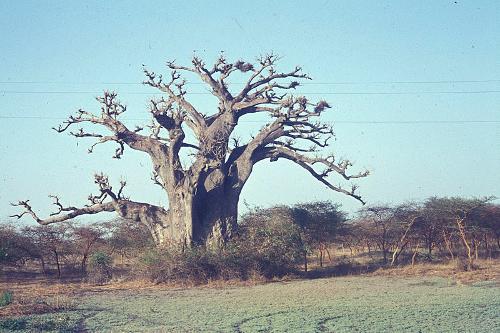 Baobab in MaliPhoto: H Grobe CC 3.0 Unported no changes made
Baobab in MaliPhoto: H Grobe CC 3.0 Unported no changes made
The Sahel zone generally has a steppe vegetation with grasses and shrubs and trees that can withstand drought well, such as acacias, cram-cram and monkey bread or baobabs. The baobab can reach a height of fifteen meters and has a huge, plump trunk. Boabab comes from the Arabic "bu hibab" which means "fruit with many seeds". The northern Sahel has many open spaces and some thorny scrub.
The Sahara is largely bare with only some vegetation in the southern part. It is estimated that 25% of Mali is covered with pastureland, 7% is covered with forest and 2% is agricultural area. The rest of the ground is fallow.
Animals
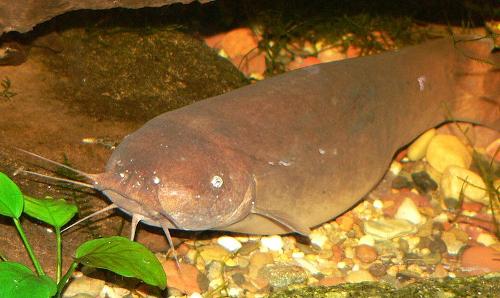 Catfish, MaliPhoto:Stan Shebs CC 3.0 Unported no changes made
Catfish, MaliPhoto:Stan Shebs CC 3.0 Unported no changes made
The animal world of Mali does not have much to offer the tourist anymore. Big game in particular is under severe threat from increasing drought and the advancing desert. The people have taken all the places where water can still be found. In addition, the locals hunt practically anything that moves. Furthermore, there are only a few nature reserves where the animals can feel relatively safe. The most wild is therefore found in the west and south of the country. Mali is more known for its large numbers of cattle, sheep and goats. The two main bovine species are zebu and taurines. The zebu is found throughout the Sahel and is also used for work. The taurine is a bull-like bovine and is more common in the south and on the savannas. The Sahel sheep and the Guinea goat are kept for the meat, Macina sheep for the wool and the Sahel goat is a good milk producer. The camel is of course a familiar sight in the desert areas.
When it comes to birds, you can still indulge yourself in Mali. There are hundreds of species in Mali (ca. 650), especially along the Niger, but also in the northern Timbuktu. In the rivers and lakes of Mali there are about 200 species of fish, including the delicious "capitaine" and also carp, dogfish, and various types of catfish.
Mammals
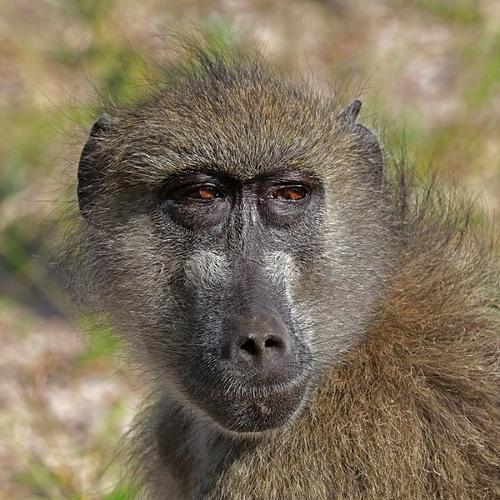 Baboon, MaliPhoto: Charles James Sharp CC 4.0 International no changes made
Baboon, MaliPhoto: Charles James Sharp CC 4.0 International no changes made
The Parc National de la Boucle du Baoulé is located northwest of the capital Bamako. The best time to visit that park is from mid-October to December. In the rainy season the park is virtually impassable and from January the area is ravaged by savanna fires. There is a reasonable chance to see warthogs, pygmy antelopes, baboons, green meerkats and hussar monkeys in this park. Only residual populations of desert antelopes such as algazel and addax can be found.
The Réservé des éléphants du Gouma is located on the road from Gao to Mopti. Small herds of elephants can be seen here from November to March. Outside the parks, mongooses and hyraxes can be found in rocky areas, and occasionally divers, klipspringers, foxes and jackals.
Hippos, crocodiles and Nile monitor lizards live in the Niger Delta. Throughout Mali you almost stumble over the lizards and in the evening many toads appear.
Birds
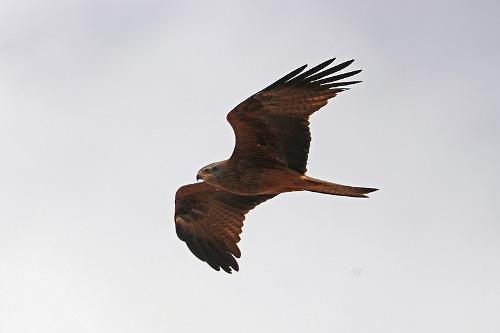 Black Kite, MaliPhoto: Charles James Sharp CC 4.0 International no changes made
Black Kite, MaliPhoto: Charles James Sharp CC 4.0 International no changes made
The black kite is the most common bird of prey in Mali. The European variant occurs as a migratory bird. The African fish-hunting eagle is not so common anymore. The little gray kite is mainly found in the Office du Niger. The hooded vulture finds its carrion both along the Niger and in drier areas, but can also be found near slaughterhouses. The Shield Raven is also a scavenger. Waders come and go along the Niger. Storks are mainly migratory birds that rest for a while in the Niger Delta. The Abdim stork lives in the drier areas. The black ibis is not really black, but brown to ocher. Heron species are plentiful: purple herons, blue herons, black-headed herons, cow herons and egrets. Special is the hammerhead, which builds huge nests of up to 1.5 meters in diameter.
Smaller waders are the lily carpet, the spur lapwing, the Senegalese curlew and the water curlew. The only common duck-like in Mali is the spur-winged goose. The pied kingfisher, malachite kingfisher and rare Senegal kingfisher are mainly found in the Niger delta and the Senegal with its tributaries where they hunt for fish. The African snake-neck bird also hunts for fish.
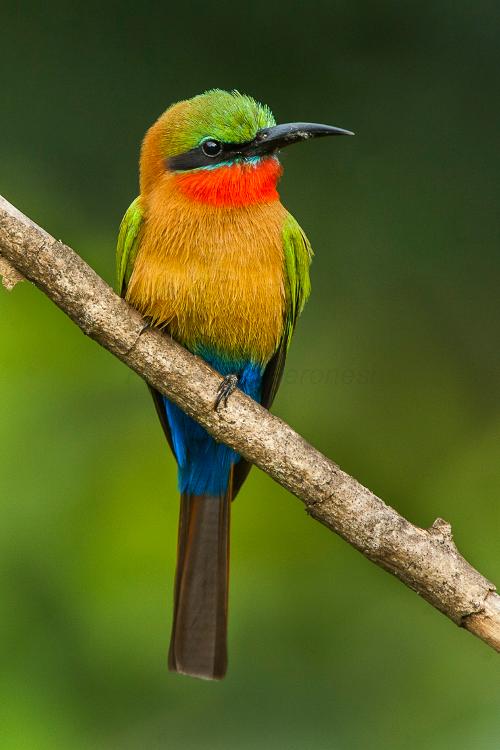 Red-throated bee-eater, MaliPhoto: Francesco Veronesi CC 2.0 Generic no changes made
Red-throated bee-eater, MaliPhoto: Francesco Veronesi CC 2.0 Generic no changes made
The bee-eaters are beautiful and colorful. Most common is the dwarf bee-eater, the red-throated bee-eater can mainly be seen in Western Mali, the carmine bee-eater in the south of Mali and we also have the small green bee-eater. Turacos include Senegalese spur cuckoo, violet turaco, pied peasant, ring-necked parakeet and gray banana-eater.
Hornbills are notable for their huge downward curled beak. They mainly live in the trees; some species are the gray tok and the red-billed tuft. The different pigeon species mainly live in the cities and villages, because that is where the most food can be found. Well-known apparitions are the weeping dove, the palm dove and the large speckled pigeon. The noisy Green-tailed Glossy Starling and the Green Long-tailed Glossy Starling are also mainly observed in villages and towns. There are also 116 types of weavers who weave beautiful nests. Each species has its own architectural style. Some types of weaver are the Napoleon weaver, the large textor weaver, the white-billed buffalo weaver and the grenadier weaver.
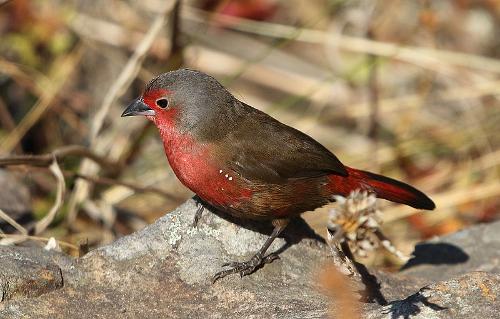 Fire finch, MaliPhoto: Alandmanso CC 4.0 International no changes made
Fire finch, MaliPhoto: Alandmanso CC 4.0 International no changes made
One of the most striking birds of Mali is the Malian fire finch. The male is burgundy with a brown beak while the female is brown with a burgundy beak. It is also Mali's only native bird.
Sources
Te gast in Mali
Verre Reizen
Velton, R. / Mali
Bradt
Vlugt, B. / Mali
Gottmer
Westen, G. van / Mali : mensen, politiek, economie, cultuur
Koninklijk Instituut voor de Tropen
CIA - World Factbook
BBC - Country Profiles
Copyright: Team The World of Info